Rural Hall, NC Map & Demographics
Rural Hall Map
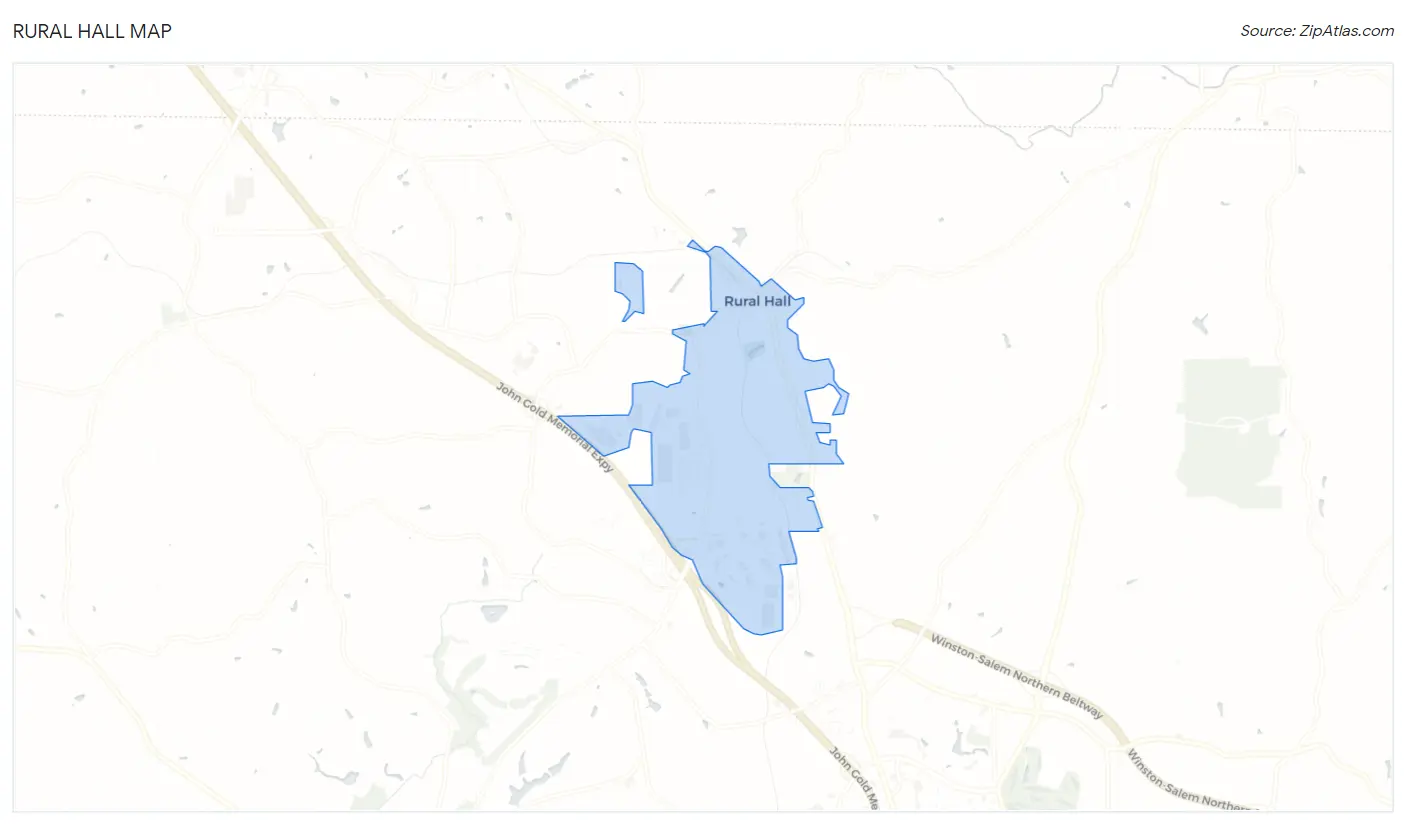
Rural Hall Overview
$37,702
PER CAPITA INCOME
$71,987
AVG FAMILY INCOME
$56,037
AVG HOUSEHOLD INCOME
17.4%
WAGE / INCOME GAP [ % ]
82.6¢/ $1
WAGE / INCOME GAP [ $ ]
0.48
INEQUALITY / GINI INDEX
3,376
TOTAL POPULATION
1,459
MALE POPULATION
1,917
FEMALE POPULATION
76.11
MALES / 100 FEMALES
131.39
FEMALES / 100 MALES
46.8
MEDIAN AGE
2.7
AVG FAMILY SIZE
2.1
AVG HOUSEHOLD SIZE
1,721
LABOR FORCE [ PEOPLE ]
59.5%
PERCENT IN LABOR FORCE
13.4%
UNEMPLOYMENT RATE
Rural Hall Zip Codes
Rural Hall Area Codes
Income in Rural Hall
Income Overview in Rural Hall
Per Capita Income in Rural Hall is $37,702, while median incomes of families and households are $71,987 and $56,037 respectively.
| Characteristic | Number | Measure |
| Per Capita Income | 3,376 | $37,702 |
| Median Family Income | 910 | $71,987 |
| Mean Family Income | 910 | $112,361 |
| Median Household Income | 1,637 | $56,037 |
| Mean Household Income | 1,637 | $82,652 |
| Income Deficit | 910 | $0 |
| Wage / Income Gap (%) | 3,376 | 17.39% |
| Wage / Income Gap ($) | 3,376 | 82.61¢ per $1 |
| Gini / Inequality Index | 3,376 | 0.48 |
Earnings by Sex in Rural Hall
Average Earnings in Rural Hall are $40,104, $42,830 for men and $35,383 for women, a difference of 17.4%.

| Sex | Number | Average Earnings |
| Male | 925 (52.7%) | $42,830 |
| Female | 829 (47.3%) | $35,383 |
| Total | 1,754 (100.0%) | $40,104 |
Earnings by Sex by Income Bracket in Rural Hall
The most common earnings brackets in Rural Hall are $40,000 to $44,999 for men (174 | 18.8%) and $22,500 to $24,999 for women (242 | 29.2%).
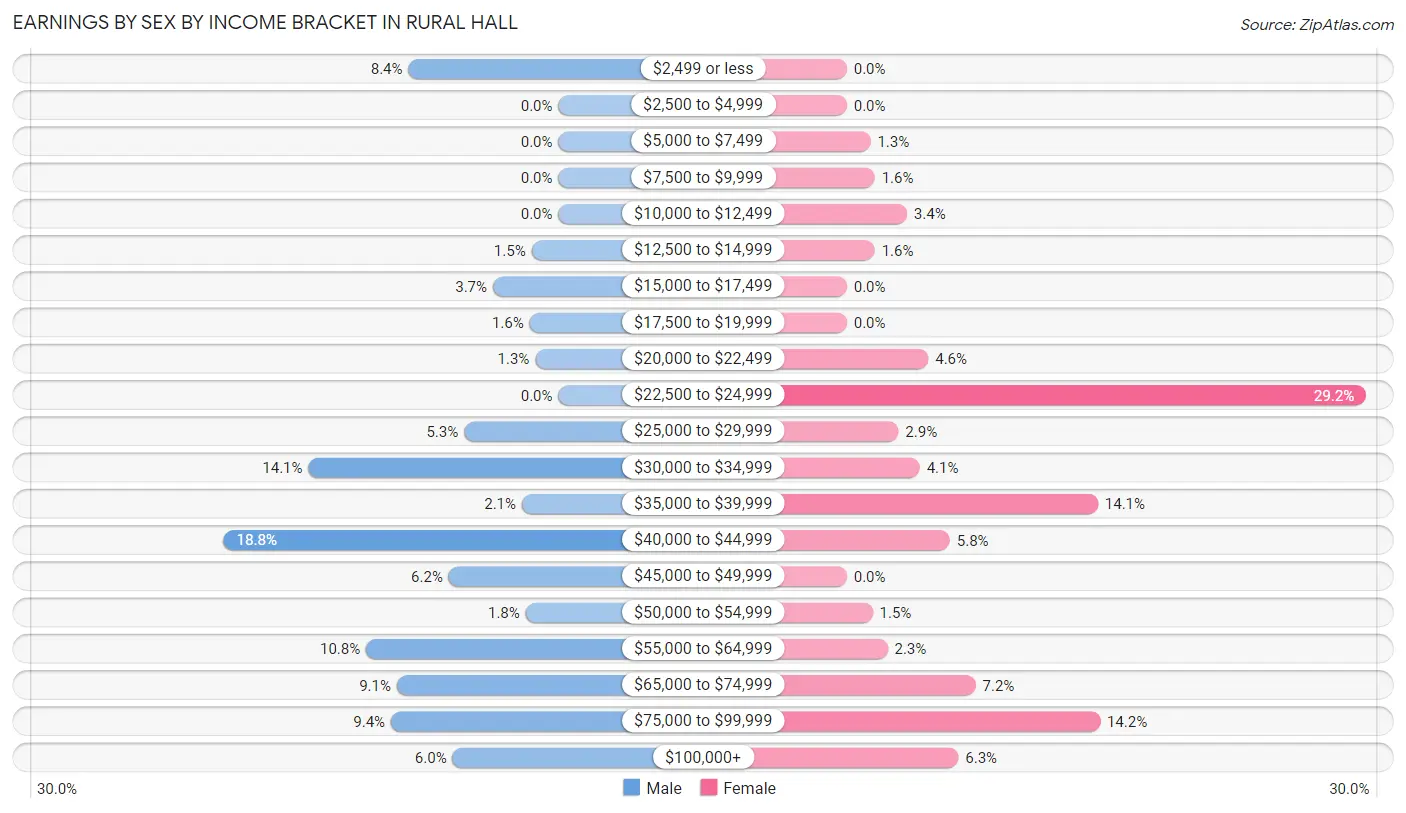
| Income | Male | Female |
| $2,499 or less | 78 (8.4%) | 0 (0.0%) |
| $2,500 to $4,999 | 0 (0.0%) | 0 (0.0%) |
| $5,000 to $7,499 | 0 (0.0%) | 11 (1.3%) |
| $7,500 to $9,999 | 0 (0.0%) | 13 (1.6%) |
| $10,000 to $12,499 | 0 (0.0%) | 28 (3.4%) |
| $12,500 to $14,999 | 14 (1.5%) | 13 (1.6%) |
| $15,000 to $17,499 | 34 (3.7%) | 0 (0.0%) |
| $17,500 to $19,999 | 15 (1.6%) | 0 (0.0%) |
| $20,000 to $22,499 | 12 (1.3%) | 38 (4.6%) |
| $22,500 to $24,999 | 0 (0.0%) | 242 (29.2%) |
| $25,000 to $29,999 | 49 (5.3%) | 24 (2.9%) |
| $30,000 to $34,999 | 130 (14.1%) | 34 (4.1%) |
| $35,000 to $39,999 | 19 (2.1%) | 117 (14.1%) |
| $40,000 to $44,999 | 174 (18.8%) | 48 (5.8%) |
| $45,000 to $49,999 | 57 (6.2%) | 0 (0.0%) |
| $50,000 to $54,999 | 17 (1.8%) | 12 (1.5%) |
| $55,000 to $64,999 | 100 (10.8%) | 19 (2.3%) |
| $65,000 to $74,999 | 84 (9.1%) | 60 (7.2%) |
| $75,000 to $99,999 | 87 (9.4%) | 118 (14.2%) |
| $100,000+ | 55 (5.9%) | 52 (6.3%) |
| Total | 925 (100.0%) | 829 (100.0%) |
Earnings by Sex by Educational Attainment in Rural Hall
Average earnings in Rural Hall are $43,889 for men and $35,833 for women, a difference of 18.4%. Men with an educational attainment of college or associate's degree enjoy the highest average annual earnings of $57,813, while those with less than high school education earn the least with $40,426. Women with an educational attainment of bachelor's degree earn the most with the average annual earnings of $40,054, while those with high school diploma education have the smallest earnings of $24,286.

| Educational Attainment | Male Income | Female Income |
| Less than High School | $40,426 | $0 |
| High School Diploma | $42,716 | $24,286 |
| College or Associate's Degree | $57,813 | $38,935 |
| Bachelor's Degree | $48,807 | $40,054 |
| Graduate Degree | - | - |
| Total | $43,889 | $35,833 |
Family Income in Rural Hall
Family Income Brackets in Rural Hall
According to the Rural Hall family income data, there are 191 families falling into the $35,000 to $49,999 income range, which is the most common income bracket and makes up 21.0% of all families.

| Income Bracket | # Families | % Families |
| Less than $10,000 | 0 | 0.0% |
| $10,000 to $14,999 | 0 | 0.0% |
| $15,000 to $24,999 | 13 | 1.4% |
| $25,000 to $34,999 | 76 | 8.4% |
| $35,000 to $49,999 | 191 | 21.0% |
| $50,000 to $74,999 | 191 | 21.0% |
| $75,000 to $99,999 | 165 | 18.1% |
| $100,000 to $149,999 | 161 | 17.7% |
| $150,000 to $199,999 | 77 | 8.5% |
| $200,000+ | 36 | 4.0% |
Family Income by Famaliy Size in Rural Hall
3-person families (230 | 25.3%) account for the highest median family income in Rural Hall with $98,750 per family, while 3-person families (230 | 25.3%) have the highest median income of $32,917 per family member.

| Income Bracket | # Families | Median Income |
| 2-Person Families | 571 (62.7%) | $63,750 |
| 3-Person Families | 230 (25.3%) | $98,750 |
| 4-Person Families | 71 (7.8%) | $96,696 |
| 5-Person Families | 20 (2.2%) | $0 |
| 6-Person Families | 18 (2.0%) | $0 |
| 7+ Person Families | 0 (0.0%) | $0 |
| Total | 910 (100.0%) | $71,987 |
Family Income by Number of Earners in Rural Hall
The median family income in Rural Hall is $71,987, with families comprising 3+ earners (61) having the highest median family income of $178,295, while families with 1 earner (355) have the lowest median family income of $49,073, accounting for 6.7% and 39.0% of families, respectively.

| Number of Earners | # Families | Median Income |
| No Earners | 186 (20.4%) | $65,385 |
| 1 Earner | 355 (39.0%) | $49,073 |
| 2 Earners | 308 (33.9%) | $122,719 |
| 3+ Earners | 61 (6.7%) | $178,295 |
| Total | 910 (100.0%) | $71,987 |
Household Income in Rural Hall
Household Income Brackets in Rural Hall
With 286 households falling in the category, the $35,000 to $49,999 income range is the most frequent in Rural Hall, accounting for 17.5% of all households. In contrast, only 15 households (0.9%) fall into the $10,000 to $14,999 income bracket, making it the least populous group.

| Income Bracket | # Households | % Households |
| Less than $10,000 | 36 | 2.2% |
| $10,000 to $14,999 | 15 | 0.9% |
| $15,000 to $24,999 | 239 | 14.6% |
| $25,000 to $34,999 | 205 | 12.5% |
| $35,000 to $49,999 | 286 | 17.5% |
| $50,000 to $74,999 | 262 | 16.0% |
| $75,000 to $99,999 | 241 | 14.7% |
| $100,000 to $149,999 | 242 | 14.8% |
| $150,000 to $199,999 | 77 | 4.7% |
| $200,000+ | 36 | 2.2% |
Household Income by Householder Age in Rural Hall
The median household income in Rural Hall is $56,037, with the highest median household income of $70,265 found in the 25 to 44 years age bracket for the primary householder. A total of 496 households (30.3%) fall into this category. Meanwhile, the 15 to 24 years age bracket for the primary householder has the lowest median household income of $0, with 17 households (1.0%) in this group.

| Income Bracket | # Households | Median Income |
| 15 to 24 Years | 17 (1.0%) | $0 |
| 25 to 44 Years | 496 (30.3%) | $70,265 |
| 45 to 64 Years | 608 (37.1%) | $56,649 |
| 65+ Years | 516 (31.5%) | $41,042 |
| Total | 1,637 (100.0%) | $56,037 |
Poverty in Rural Hall
Income Below Poverty by Sex and Age in Rural Hall
With 8.2% poverty level for males and 4.5% for females among the residents of Rural Hall, under 5 year old males and 12 to 14 year old females are the most vulnerable to poverty, with 25 males (100.0%) and 25 females (28.1%) in their respective age groups living below the poverty level.
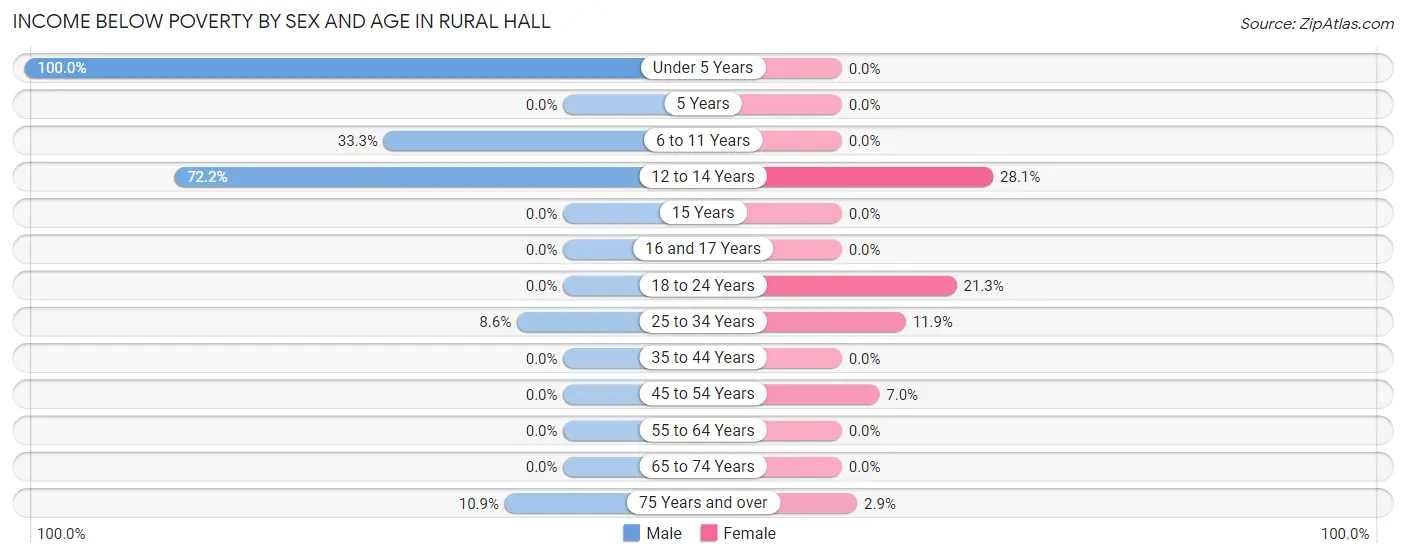
| Age Bracket | Male | Female |
| Under 5 Years | 25 (100.0%) | 0 (0.0%) |
| 5 Years | 0 (0.0%) | 0 (0.0%) |
| 6 to 11 Years | 25 (33.3%) | 0 (0.0%) |
| 12 to 14 Years | 26 (72.2%) | 25 (28.1%) |
| 15 Years | 0 (0.0%) | 0 (0.0%) |
| 16 and 17 Years | 0 (0.0%) | 0 (0.0%) |
| 18 to 24 Years | 0 (0.0%) | 13 (21.3%) |
| 25 to 34 Years | 18 (8.6%) | 21 (11.9%) |
| 35 to 44 Years | 0 (0.0%) | 0 (0.0%) |
| 45 to 54 Years | 0 (0.0%) | 17 (7.0%) |
| 55 to 64 Years | 0 (0.0%) | 0 (0.0%) |
| 65 to 74 Years | 0 (0.0%) | 0 (0.0%) |
| 75 Years and over | 25 (10.9%) | 11 (2.9%) |
| Total | 119 (8.2%) | 87 (4.5%) |
Income Above Poverty by Sex and Age in Rural Hall
According to the poverty statistics in Rural Hall, males aged 15 years and females aged under 5 years are the age groups that are most secure financially, with 100.0% of males and 100.0% of females in these age groups living above the poverty line.
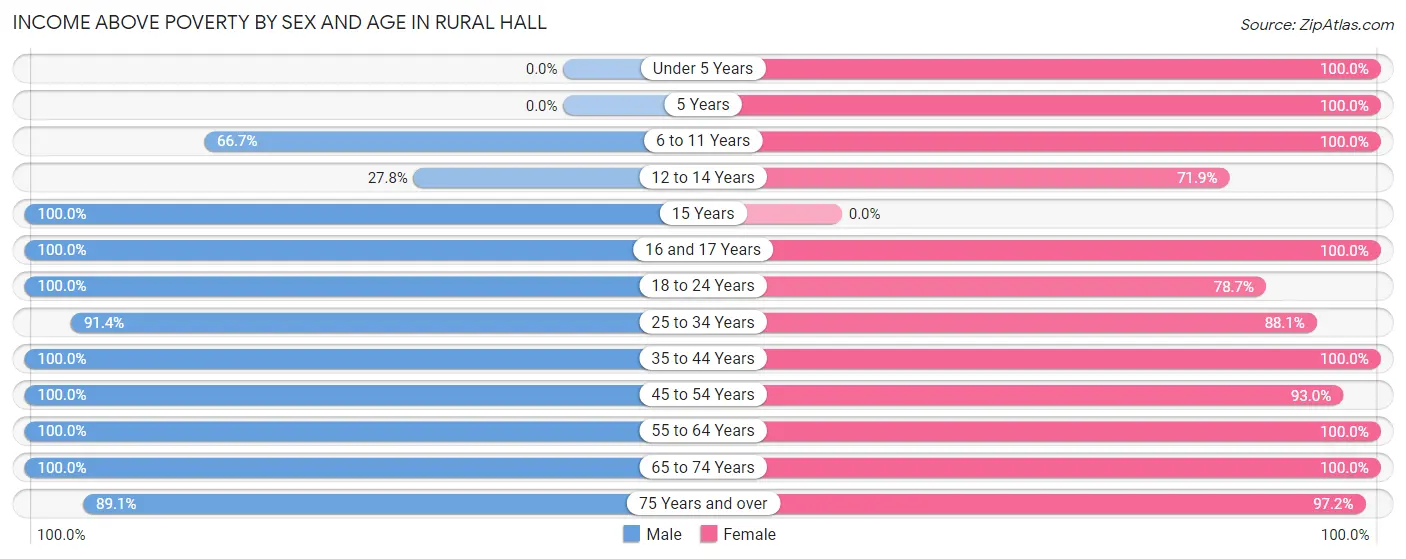
| Age Bracket | Male | Female |
| Under 5 Years | 0 (0.0%) | 114 (100.0%) |
| 5 Years | 0 (0.0%) | 17 (100.0%) |
| 6 to 11 Years | 50 (66.7%) | 116 (100.0%) |
| 12 to 14 Years | 10 (27.8%) | 64 (71.9%) |
| 15 Years | 11 (100.0%) | 0 (0.0%) |
| 16 and 17 Years | 12 (100.0%) | 20 (100.0%) |
| 18 to 24 Years | 75 (100.0%) | 48 (78.7%) |
| 25 to 34 Years | 191 (91.4%) | 156 (88.1%) |
| 35 to 44 Years | 203 (100.0%) | 353 (100.0%) |
| 45 to 54 Years | 217 (100.0%) | 227 (93.0%) |
| 55 to 64 Years | 259 (100.0%) | 237 (100.0%) |
| 65 to 74 Years | 107 (100.0%) | 103 (100.0%) |
| 75 Years and over | 205 (89.1%) | 375 (97.2%) |
| Total | 1,340 (91.8%) | 1,830 (95.5%) |
Income Below Poverty Among Married-Couple Families in Rural Hall
The poverty statistics for married-couple families in Rural Hall show that 2.6% or 18 of the total 687 families live below the poverty line. Families with 3 or 4 children have the highest poverty rate of 66.7%, comprising of 18 families. On the other hand, families with no children have the lowest poverty rate of 0.0%, which includes 0 families.

| Children | Above Poverty | Below Poverty |
| No Children | 462 (100.0%) | 0 (0.0%) |
| 1 or 2 Children | 198 (100.0%) | 0 (0.0%) |
| 3 or 4 Children | 9 (33.3%) | 18 (66.7%) |
| 5 or more Children | 0 (0.0%) | 0 (0.0%) |
| Total | 669 (97.4%) | 18 (2.6%) |
Income Below Poverty Among Single-Parent Households in Rural Hall

| Children | Single Father | Single Mother |
| No Children | 0 (0.0%) | 0 (0.0%) |
| 1 or 2 Children | 0 (0.0%) | 0 (0.0%) |
| 3 or 4 Children | 0 (0.0%) | 0 (0.0%) |
| 5 or more Children | 0 (0.0%) | 0 (0.0%) |
| Total | 0 (0.0%) | 0 (0.0%) |
Income Below Poverty Among Married-Couple vs Single-Parent Households in Rural Hall

| Children | Married-Couple Families | Single-Parent Households |
| No Children | 0 (0.0%) | 0 (0.0%) |
| 1 or 2 Children | 0 (0.0%) | 0 (0.0%) |
| 3 or 4 Children | 18 (66.7%) | 0 (0.0%) |
| 5 or more Children | 0 (0.0%) | 0 (0.0%) |
| Total | 18 (2.6%) | 0 (0.0%) |
Race in Rural Hall
The most populous races in Rural Hall are White / Caucasian (2,729 | 80.8%), Black / African American (597 | 17.7%), and Hispanic or Latino (224 | 6.6%).

| Race | # Population | % Population |
| Asian | 0 | 0.0% |
| Black / African American | 597 | 17.7% |
| Hawaiian / Pacific | 3 | 0.1% |
| Hispanic or Latino | 224 | 6.6% |
| Native / Alaskan | 17 | 0.5% |
| White / Caucasian | 2,729 | 80.8% |
| Two or more Races | 30 | 0.9% |
| Some other Race | 0 | 0.0% |
| Total | 3,376 | 100.0% |
Ancestry in Rural Hall
The most populous ancestries reported in Rural Hall are American (388 | 11.5%), English (386 | 11.4%), Irish (319 | 9.5%), German (283 | 8.4%), and Scottish (193 | 5.7%), together accounting for 46.5% of all Rural Hall residents.
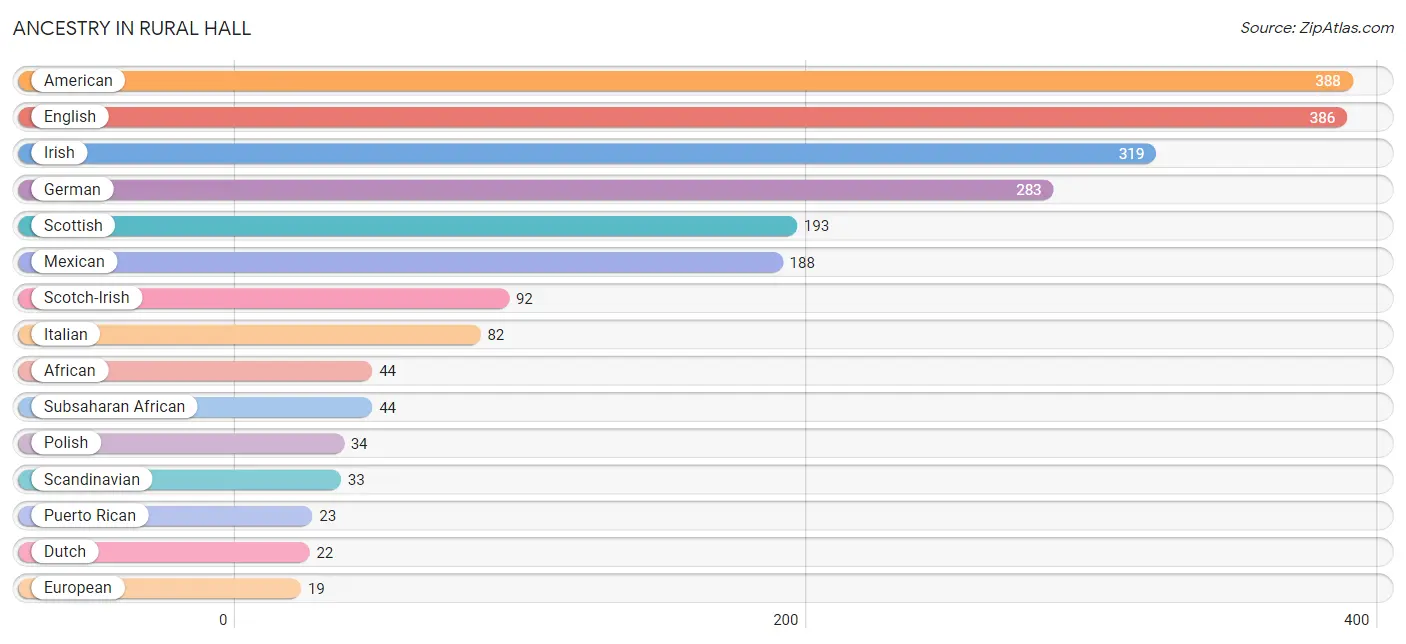
| Ancestry | # Population | % Population |
| African | 44 | 1.3% |
| American | 388 | 11.5% |
| Belgian | 13 | 0.4% |
| Dutch | 22 | 0.6% |
| Ecuadorian | 13 | 0.4% |
| English | 386 | 11.4% |
| European | 19 | 0.6% |
| French | 18 | 0.5% |
| German | 283 | 8.4% |
| Greek | 19 | 0.6% |
| Indian (Asian) | 17 | 0.5% |
| Irish | 319 | 9.5% |
| Italian | 82 | 2.4% |
| Mexican | 188 | 5.6% |
| Polish | 34 | 1.0% |
| Puerto Rican | 23 | 0.7% |
| Scandinavian | 33 | 1.0% |
| Scotch-Irish | 92 | 2.7% |
| Scottish | 193 | 5.7% |
| South American | 13 | 0.4% |
| Subsaharan African | 44 | 1.3% |
| Swedish | 13 | 0.4% |
| Swiss | 14 | 0.4% |
| Welsh | 14 | 0.4% | View All 24 Rows |
Immigrants in Rural Hall
The most numerous immigrant groups reported in Rural Hall came from Latin America (52 | 1.5%), Central America (39 | 1.2%), Mexico (39 | 1.2%), Eastern Europe (21 | 0.6%), and Europe (21 | 0.6%), together accounting for 5.1% of all Rural Hall residents.

| Immigration Origin | # Population | % Population |
| Central America | 39 | 1.2% |
| Eastern Europe | 21 | 0.6% |
| Ecuador | 13 | 0.4% |
| Europe | 21 | 0.6% |
| Latin America | 52 | 1.5% |
| Mexico | 39 | 1.2% |
| Poland | 21 | 0.6% |
| South America | 13 | 0.4% | View All 8 Rows |
Sex and Age in Rural Hall
Sex and Age in Rural Hall
The most populous age groups in Rural Hall are 60 to 64 Years (173 | 11.9%) for men and 40 to 44 Years (213 | 11.1%) for women.
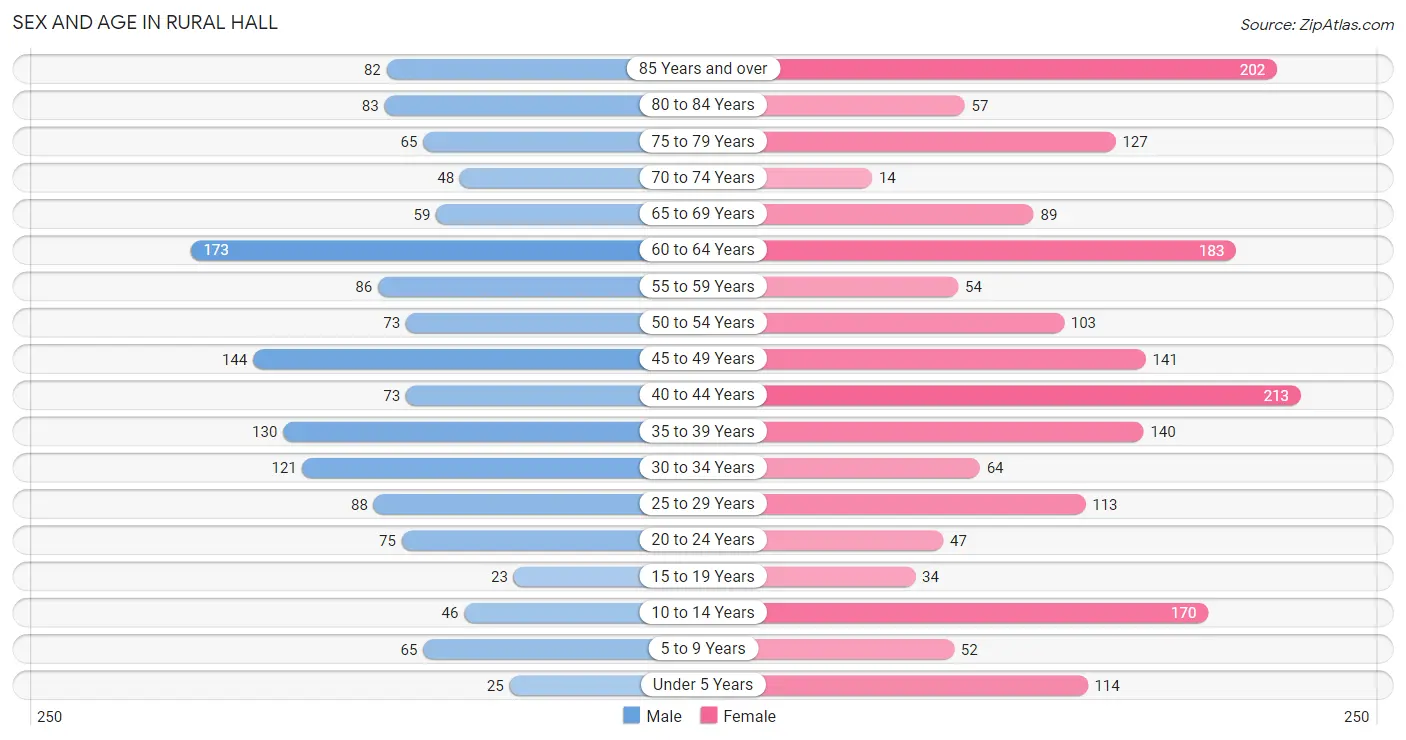
| Age Bracket | Male | Female |
| Under 5 Years | 25 (1.7%) | 114 (5.9%) |
| 5 to 9 Years | 65 (4.5%) | 52 (2.7%) |
| 10 to 14 Years | 46 (3.2%) | 170 (8.9%) |
| 15 to 19 Years | 23 (1.6%) | 34 (1.8%) |
| 20 to 24 Years | 75 (5.1%) | 47 (2.5%) |
| 25 to 29 Years | 88 (6.0%) | 113 (5.9%) |
| 30 to 34 Years | 121 (8.3%) | 64 (3.3%) |
| 35 to 39 Years | 130 (8.9%) | 140 (7.3%) |
| 40 to 44 Years | 73 (5.0%) | 213 (11.1%) |
| 45 to 49 Years | 144 (9.9%) | 141 (7.4%) |
| 50 to 54 Years | 73 (5.0%) | 103 (5.4%) |
| 55 to 59 Years | 86 (5.9%) | 54 (2.8%) |
| 60 to 64 Years | 173 (11.9%) | 183 (9.6%) |
| 65 to 69 Years | 59 (4.0%) | 89 (4.6%) |
| 70 to 74 Years | 48 (3.3%) | 14 (0.7%) |
| 75 to 79 Years | 65 (4.5%) | 127 (6.6%) |
| 80 to 84 Years | 83 (5.7%) | 57 (3.0%) |
| 85 Years and over | 82 (5.6%) | 202 (10.5%) |
| Total | 1,459 (100.0%) | 1,917 (100.0%) |
Families and Households in Rural Hall
Median Family Size in Rural Hall
The median family size in Rural Hall is 2.71 persons per family, with single female/mother families (75 | 8.2%) accounting for the largest median family size of 2.83 persons per family. On the other hand, single male/father families (148 | 16.3%) represent the smallest median family size with 2.15 persons per family.

| Family Type | # Families | Family Size |
| Married-Couple | 687 (75.5%) | 2.82 |
| Single Male/Father | 148 (16.3%) | 2.15 |
| Single Female/Mother | 75 (8.2%) | 2.83 |
| Total Families | 910 (100.0%) | 2.71 |
Median Household Size in Rural Hall
The median household size in Rural Hall is 2.06 persons per household, with single female/mother households (75 | 4.6%) accounting for the largest median household size of 2.96 persons per household. non-family households (727 | 44.4%) represent the smallest median household size with 1.18 persons per household.

| Household Type | # Households | Household Size |
| Married-Couple | 687 (42.0%) | 2.82 |
| Single Male/Father | 148 (9.0%) | 2.40 |
| Single Female/Mother | 75 (4.6%) | 2.96 |
| Non-family | 727 (44.4%) | 1.18 |
| Total Households | 1,637 (100.0%) | 2.06 |
Household Size by Marriage Status in Rural Hall
Out of a total of 1,637 households in Rural Hall, 910 (55.6%) are family households, while 727 (44.4%) are nonfamily households. The most numerous type of family households are 2-person households, comprising 540, and the most common type of nonfamily households are 1-person households, comprising 610.

| Household Size | Family Households | Nonfamily Households |
| 1-Person Households | - | 610 (37.3%) |
| 2-Person Households | 540 (33.0%) | 103 (6.3%) |
| 3-Person Households | 261 (15.9%) | 14 (0.9%) |
| 4-Person Households | 59 (3.6%) | 0 (0.0%) |
| 5-Person Households | 32 (1.9%) | 0 (0.0%) |
| 6-Person Households | 18 (1.1%) | 0 (0.0%) |
| 7+ Person Households | 0 (0.0%) | 0 (0.0%) |
| Total | 910 (55.6%) | 727 (44.4%) |
Female Fertility in Rural Hall
Fertility by Age in Rural Hall
Average fertility rate in Rural Hall is 45.0 births per 1,000 women. Women in the age bracket of 20 to 34 years have the highest fertility rate with 152.0 births per 1,000 women. Women in the age bracket of 20 to 34 years acount for 100.0% of all women with births.

| Age Bracket | Women with Births | Births / 1,000 Women |
| 15 to 19 years | 0 (0.0%) | 0.0 |
| 20 to 34 years | 34 (100.0%) | 152.0 |
| 35 to 50 years | 0 (0.0%) | 0.0 |
| Total | 34 (100.0%) | 45.0 |
Fertility by Age by Marriage Status in Rural Hall

| Age Bracket | Married | Unmarried |
| 15 to 19 years | 0 (0.0%) | 0 (0.0%) |
| 20 to 34 years | 34 (100.0%) | 0 (0.0%) |
| 35 to 50 years | 0 (0.0%) | 0 (0.0%) |
| Total | 34 (100.0%) | 0 (0.0%) |
Fertility by Education in Rural Hall
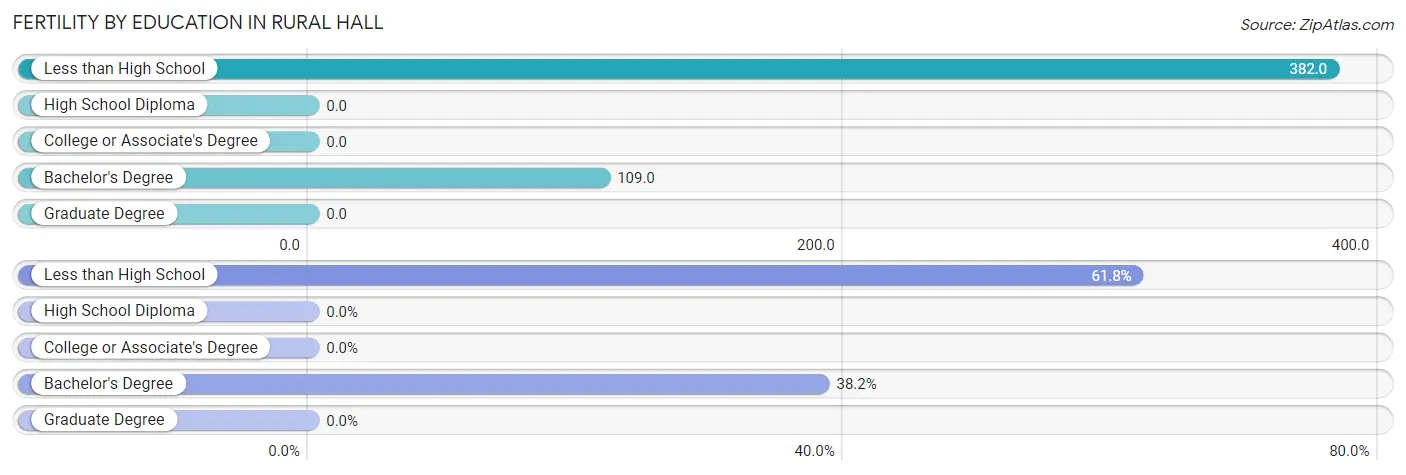
| Educational Attainment | Women with Births | Births / 1,000 Women |
| Less than High School | 21 (61.8%) | 382.0 |
| High School Diploma | 0 (0.0%) | 0.0 |
| College or Associate's Degree | 0 (0.0%) | 0.0 |
| Bachelor's Degree | 13 (38.2%) | 109.0 |
| Graduate Degree | 0 (0.0%) | 0.0 |
| Total | 34 (100.0%) | 45.0 |
Fertility by Education by Marriage Status in Rural Hall

| Educational Attainment | Married | Unmarried |
| Less than High School | 21 (100.0%) | 0 (0.0%) |
| High School Diploma | 0 (0.0%) | 0 (0.0%) |
| College or Associate's Degree | 0 (0.0%) | 0 (0.0%) |
| Bachelor's Degree | 13 (100.0%) | 0 (0.0%) |
| Graduate Degree | 0 (0.0%) | 0 (0.0%) |
| Total | 34 (100.0%) | 0 (0.0%) |
Employment Characteristics in Rural Hall
Employment by Class of Employer in Rural Hall
Among the 1,438 employed individuals in Rural Hall, private company employees (919 | 63.9%), local government employees (156 | 10.8%), and not-for-profit organizations (153 | 10.6%) make up the most common classes of employment.

| Employer Class | # Employees | % Employees |
| Private Company Employees | 919 | 63.9% |
| Self-Employed (Incorporated) | 48 | 3.3% |
| Self-Employed (Not Incorporated) | 86 | 6.0% |
| Not-for-profit Organizations | 153 | 10.6% |
| Local Government Employees | 156 | 10.8% |
| State Government Employees | 76 | 5.3% |
| Federal Government Employees | 0 | 0.0% |
| Unpaid Family Workers | 0 | 0.0% |
| Total | 1,438 | 100.0% |
Employment Status by Age in Rural Hall
According to the labor force statistics for Rural Hall, out of the total population over 16 years of age (2,893), 59.5% or 1,721 individuals are in the labor force, with 13.4% or 231 of them unemployed. The age group with the highest labor force participation rate is 35 to 44 years, with 92.8% or 516 individuals in the labor force. Within the labor force, the 35 to 44 years age range has the highest percentage of unemployed individuals, with 34.1% or 176 of them being unemployed.

| Age Bracket | In Labor Force | Unemployed |
| 16 to 19 Years | 14 (30.4%) | 0 (0.0%) |
| 20 to 24 Years | 95 (77.9%) | 25 (26.3%) |
| 25 to 29 Years | 123 (61.2%) | 0 (0.0%) |
| 30 to 34 Years | 164 (88.6%) | 0 (0.0%) |
| 35 to 44 Years | 516 (92.8%) | 176 (34.1%) |
| 45 to 54 Years | 367 (79.6%) | 0 (0.0%) |
| 55 to 59 Years | 106 (75.7%) | 0 (0.0%) |
| 60 to 64 Years | 258 (72.5%) | 29 (11.2%) |
| 65 to 74 Years | 53 (25.2%) | 0 (0.0%) |
| 75 Years and over | 24 (3.9%) | 0 (0.0%) |
| Total | 1,721 (59.5%) | 231 (13.4%) |
Employment Status by Educational Attainment in Rural Hall
According to labor force statistics for Rural Hall, 80.8% of individuals (1,534) out of the total population between 25 and 64 years of age (1,899) are in the labor force, with 13.4% or 206 of them being unemployed. The group with the highest labor force participation rate are those with the educational attainment of bachelor's degree or higher, with 93.5% or 435 individuals in the labor force. Within the labor force, individuals with bachelor's degree or higher education have the highest percentage of unemployment, with 25.3% or 110 of them being unemployed.

| Educational Attainment | In Labor Force | Unemployed |
| Less than High School | 94 (73.4%) | 0 (0.0%) |
| High School Diploma | 401 (75.4%) | 88 (16.5%) |
| College / Associate Degree | 604 (78.0%) | 37 (4.8%) |
| Bachelor's Degree or higher | 435 (93.5%) | 118 (25.3%) |
| Total | 1,534 (80.8%) | 254 (13.4%) |
Employment Occupations by Sex in Rural Hall
Management, Business, Science and Arts Occupations
The most common Management, Business, Science and Arts occupations in Rural Hall are Management (184 | 12.3%), Community & Social Service (181 | 12.1%), Health Diagnosing & Treating (127 | 8.5%), Education Instruction & Library (97 | 6.5%), and Health Technologists (82 | 5.5%).
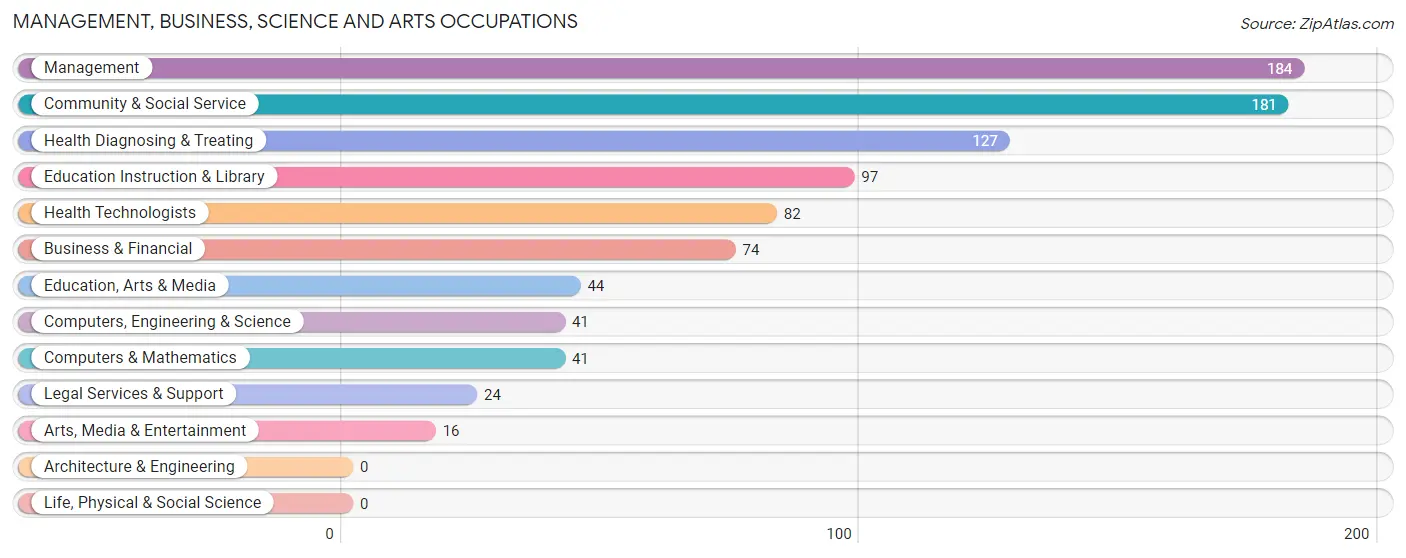
Management, Business, Science and Arts Occupations by Sex
Within the Management, Business, Science and Arts occupations in Rural Hall, the most male-oriented occupations are Education, Arts & Media (100.0%), Legal Services & Support (100.0%), and Management (76.6%), while the most female-oriented occupations are Arts, Media & Entertainment (100.0%), Health Technologists (100.0%), and Health Diagnosing & Treating (79.5%).
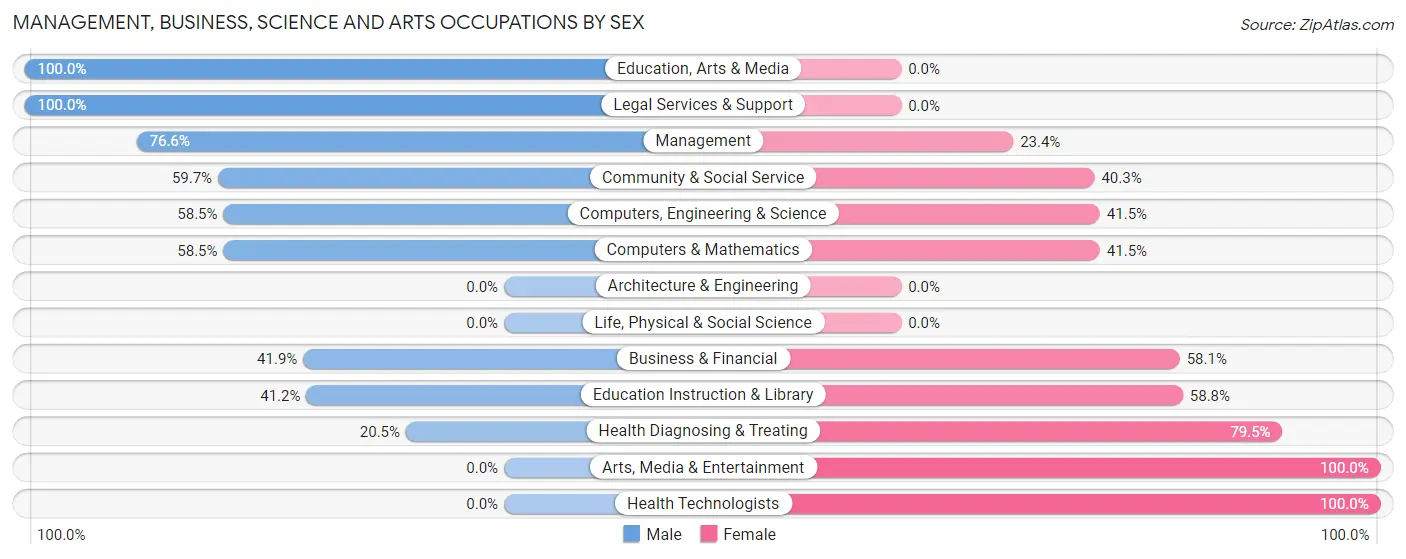
| Occupation | Male | Female |
| Management | 141 (76.6%) | 43 (23.4%) |
| Business & Financial | 31 (41.9%) | 43 (58.1%) |
| Computers, Engineering & Science | 24 (58.5%) | 17 (41.5%) |
| Computers & Mathematics | 24 (58.5%) | 17 (41.5%) |
| Architecture & Engineering | 0 (0.0%) | 0 (0.0%) |
| Life, Physical & Social Science | 0 (0.0%) | 0 (0.0%) |
| Community & Social Service | 108 (59.7%) | 73 (40.3%) |
| Education, Arts & Media | 44 (100.0%) | 0 (0.0%) |
| Legal Services & Support | 24 (100.0%) | 0 (0.0%) |
| Education Instruction & Library | 40 (41.2%) | 57 (58.8%) |
| Arts, Media & Entertainment | 0 (0.0%) | 16 (100.0%) |
| Health Diagnosing & Treating | 26 (20.5%) | 101 (79.5%) |
| Health Technologists | 0 (0.0%) | 82 (100.0%) |
| Total (Category) | 330 (54.4%) | 277 (45.6%) |
| Total (Overall) | 822 (55.2%) | 668 (44.8%) |
Services Occupations
The most common Services occupations in Rural Hall are Personal Care & Service (76 | 5.1%), Food Preparation & Serving (25 | 1.7%), Healthcare Support (23 | 1.5%), and Cleaning & Maintenance (11 | 0.7%).

Services Occupations by Sex
Within the Services occupations in Rural Hall, the most male-oriented occupations are Personal Care & Service (100.0%), and Food Preparation & Serving (48.0%), while the most female-oriented occupations are Healthcare Support (100.0%), Cleaning & Maintenance (100.0%), and Food Preparation & Serving (52.0%).

| Occupation | Male | Female |
| Healthcare Support | 0 (0.0%) | 23 (100.0%) |
| Security & Protection | 0 (0.0%) | 0 (0.0%) |
| Firefighting & Prevention | 0 (0.0%) | 0 (0.0%) |
| Law Enforcement | 0 (0.0%) | 0 (0.0%) |
| Food Preparation & Serving | 12 (48.0%) | 13 (52.0%) |
| Cleaning & Maintenance | 0 (0.0%) | 11 (100.0%) |
| Personal Care & Service | 76 (100.0%) | 0 (0.0%) |
| Total (Category) | 88 (65.2%) | 47 (34.8%) |
| Total (Overall) | 822 (55.2%) | 668 (44.8%) |
Sales and Office Occupations
The most common Sales and Office occupations in Rural Hall are Office & Administration (266 | 17.8%), and Sales & Related (135 | 9.1%).

Sales and Office Occupations by Sex

| Occupation | Male | Female |
| Sales & Related | 0 (0.0%) | 135 (100.0%) |
| Office & Administration | 70 (26.3%) | 196 (73.7%) |
| Total (Category) | 70 (17.5%) | 331 (82.5%) |
| Total (Overall) | 822 (55.2%) | 668 (44.8%) |
Natural Resources, Construction and Maintenance Occupations
The most common Natural Resources, Construction and Maintenance occupations in Rural Hall are Installation, Maintenance & Repair (155 | 10.4%), and Construction & Extraction (22 | 1.5%).

Natural Resources, Construction and Maintenance Occupations by Sex

| Occupation | Male | Female |
| Farming, Fishing & Forestry | 0 (0.0%) | 0 (0.0%) |
| Construction & Extraction | 22 (100.0%) | 0 (0.0%) |
| Installation, Maintenance & Repair | 155 (100.0%) | 0 (0.0%) |
| Total (Category) | 177 (100.0%) | 0 (0.0%) |
| Total (Overall) | 822 (55.2%) | 668 (44.8%) |
Production, Transportation and Moving Occupations
The most common Production, Transportation and Moving occupations in Rural Hall are Production (78 | 5.2%), Transportation (67 | 4.5%), and Material Moving (25 | 1.7%).

Production, Transportation and Moving Occupations by Sex

| Occupation | Male | Female |
| Production | 65 (83.3%) | 13 (16.7%) |
| Transportation | 67 (100.0%) | 0 (0.0%) |
| Material Moving | 25 (100.0%) | 0 (0.0%) |
| Total (Category) | 157 (92.3%) | 13 (7.6%) |
| Total (Overall) | 822 (55.2%) | 668 (44.8%) |
Employment Industries by Sex in Rural Hall
Employment Industries in Rural Hall
The major employment industries in Rural Hall include Health Care & Social Assistance (199 | 13.4%), Manufacturing (197 | 13.2%), Retail Trade (159 | 10.7%), Finance & Insurance (158 | 10.6%), and Transportation & Warehousing (137 | 9.2%).
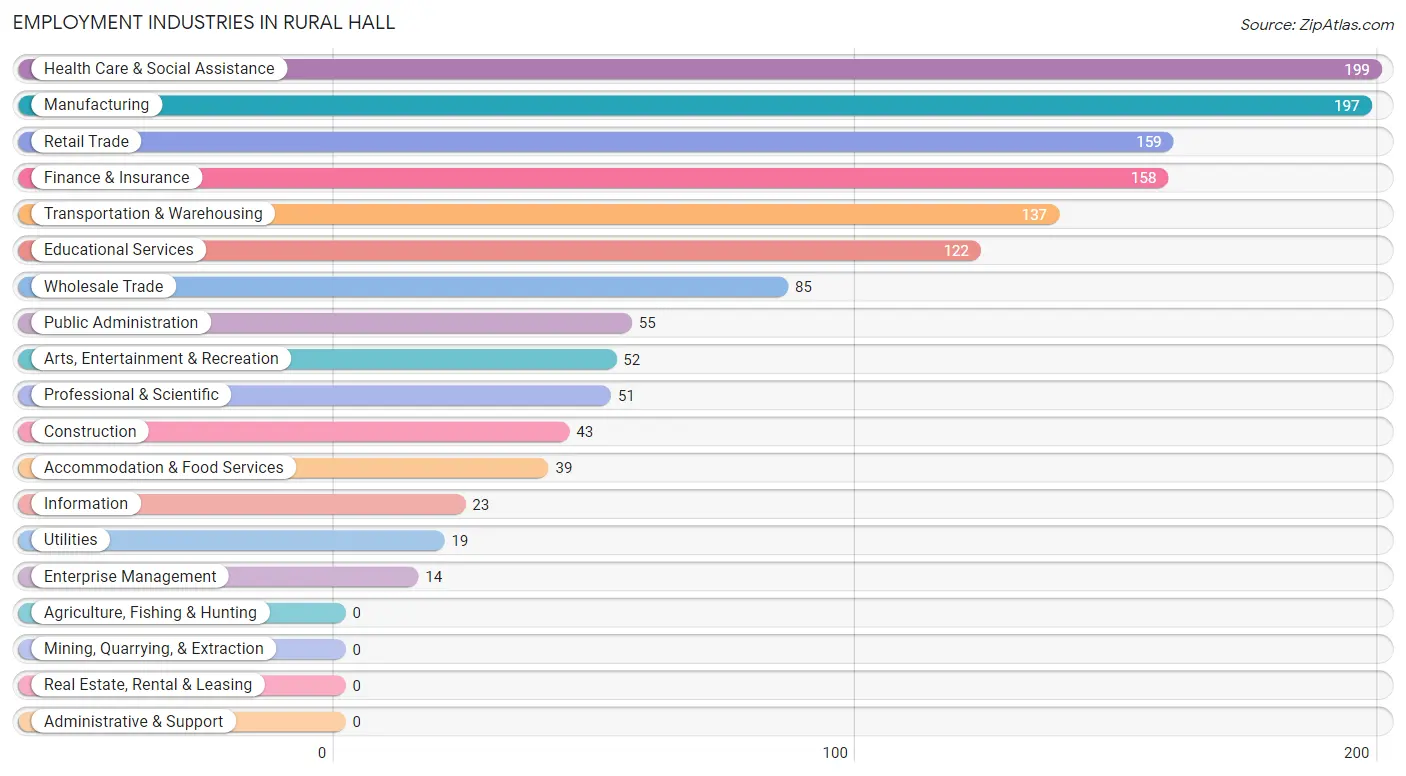
Employment Industries by Sex in Rural Hall
The Rural Hall industries that see more men than women are Construction (100.0%), Transportation & Warehousing (100.0%), and Utilities (100.0%), whereas the industries that tend to have a higher number of women are Enterprise Management (100.0%), Arts, Entertainment & Recreation (100.0%), and Finance & Insurance (87.3%).
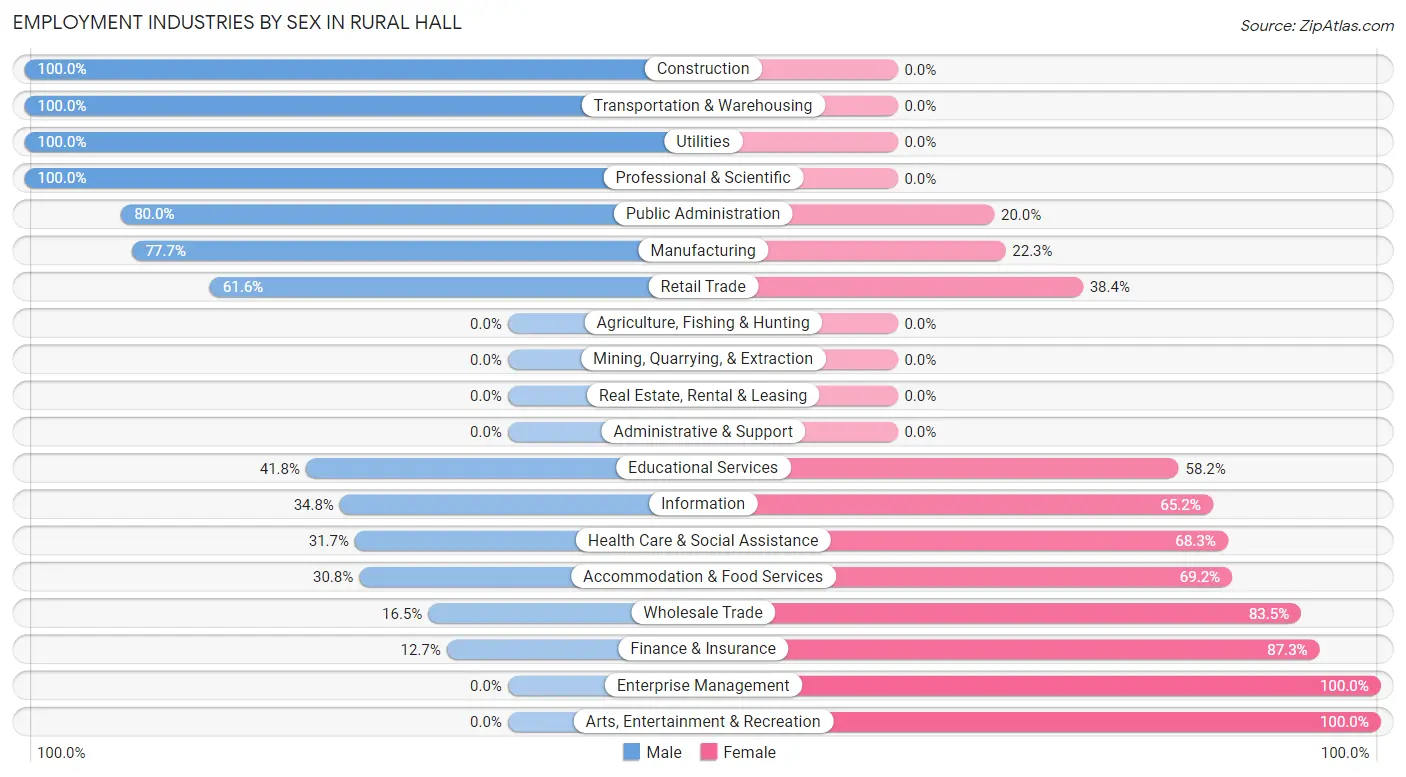
| Industry | Male | Female |
| Agriculture, Fishing & Hunting | 0 (0.0%) | 0 (0.0%) |
| Mining, Quarrying, & Extraction | 0 (0.0%) | 0 (0.0%) |
| Construction | 43 (100.0%) | 0 (0.0%) |
| Manufacturing | 153 (77.7%) | 44 (22.3%) |
| Wholesale Trade | 14 (16.5%) | 71 (83.5%) |
| Retail Trade | 98 (61.6%) | 61 (38.4%) |
| Transportation & Warehousing | 137 (100.0%) | 0 (0.0%) |
| Utilities | 19 (100.0%) | 0 (0.0%) |
| Information | 8 (34.8%) | 15 (65.2%) |
| Finance & Insurance | 20 (12.7%) | 138 (87.3%) |
| Real Estate, Rental & Leasing | 0 (0.0%) | 0 (0.0%) |
| Professional & Scientific | 51 (100.0%) | 0 (0.0%) |
| Enterprise Management | 0 (0.0%) | 14 (100.0%) |
| Administrative & Support | 0 (0.0%) | 0 (0.0%) |
| Educational Services | 51 (41.8%) | 71 (58.2%) |
| Health Care & Social Assistance | 63 (31.7%) | 136 (68.3%) |
| Arts, Entertainment & Recreation | 0 (0.0%) | 52 (100.0%) |
| Accommodation & Food Services | 12 (30.8%) | 27 (69.2%) |
| Public Administration | 44 (80.0%) | 11 (20.0%) |
| Total | 822 (55.2%) | 668 (44.8%) |
Education in Rural Hall
School Enrollment in Rural Hall
The most common levels of schooling among the 622 students in Rural Hall are middle school (206 | 33.1%), graduate / professional (122 | 19.6%), and elementary school (110 | 17.7%).

| School Level | # Students | % Students |
| Nursery / Preschool | 28 | 4.5% |
| Kindergarten | 0 | 0.0% |
| Elementary School | 110 | 17.7% |
| Middle School | 206 | 33.1% |
| High School | 75 | 12.1% |
| College / Undergraduate | 81 | 13.0% |
| Graduate / Professional | 122 | 19.6% |
| Total | 622 | 100.0% |
School Enrollment by Age by Funding Source in Rural Hall
Out of a total of 622 students who are enrolled in schools in Rural Hall, 110 (17.7%) attend a private institution, while the remaining 512 (82.3%) are enrolled in public schools. The age group of 35 years and over has the highest likelihood of being enrolled in private schools, with 110 (74.3% in the age bracket) enrolled. Conversely, the age group of 3 to 4 year olds has the lowest likelihood of being enrolled in a private school, with 11 (100.0% in the age bracket) attending a public institution.

| Age Bracket | Public School | Private School |
| 3 to 4 Year Olds | 11 (100.0%) | 0 (0.0%) |
| 5 to 9 Year Old | 117 (100.0%) | 0 (0.0%) |
| 10 to 14 Year Olds | 216 (100.0%) | 0 (0.0%) |
| 15 to 17 Year Olds | 43 (100.0%) | 0 (0.0%) |
| 18 to 19 Year Olds | 14 (100.0%) | 0 (0.0%) |
| 20 to 24 Year Olds | 17 (100.0%) | 0 (0.0%) |
| 25 to 34 Year Olds | 56 (100.0%) | 0 (0.0%) |
| 35 Years and over | 38 (25.7%) | 110 (74.3%) |
| Total | 512 (82.3%) | 110 (17.7%) |
Educational Attainment by Field of Study in Rural Hall
Social sciences (162 | 23.8%), science & technology (120 | 17.6%), arts & humanities (104 | 15.3%), business (82 | 12.0%), and education (73 | 10.7%) are the most common fields of study among 681 individuals in Rural Hall who have obtained a bachelor's degree or higher.
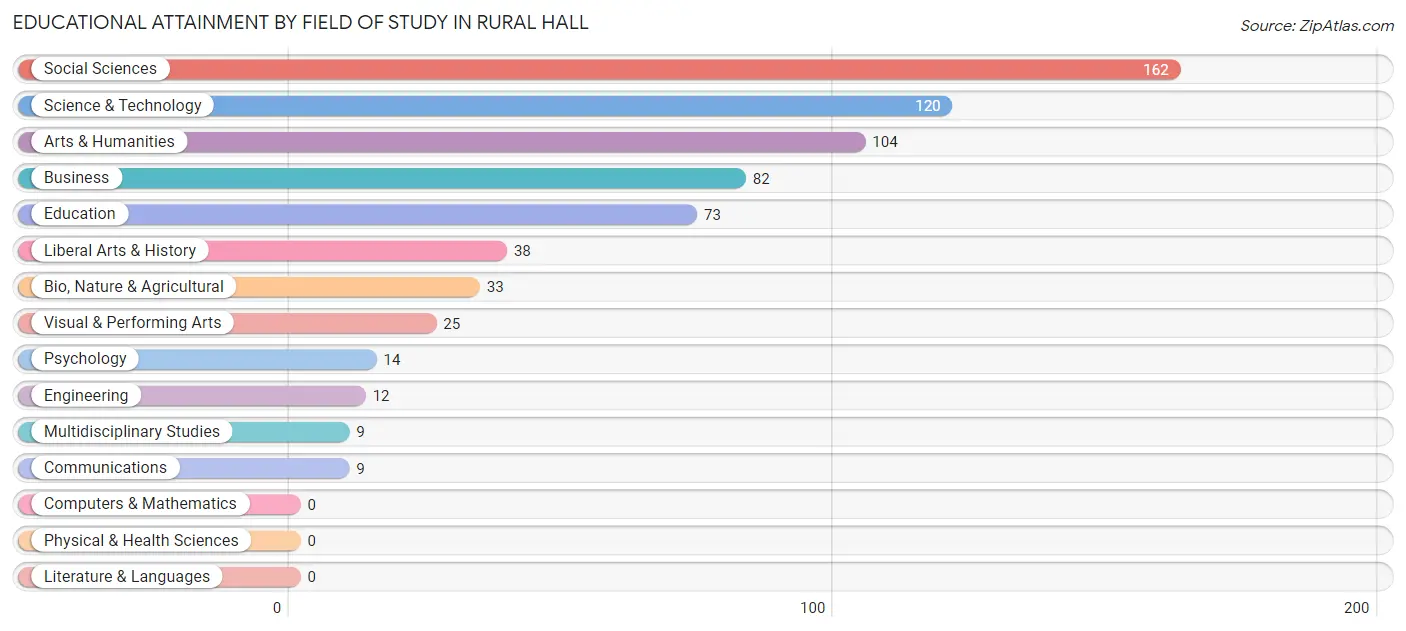
| Field of Study | # Graduates | % Graduates |
| Computers & Mathematics | 0 | 0.0% |
| Bio, Nature & Agricultural | 33 | 4.9% |
| Physical & Health Sciences | 0 | 0.0% |
| Psychology | 14 | 2.1% |
| Social Sciences | 162 | 23.8% |
| Engineering | 12 | 1.8% |
| Multidisciplinary Studies | 9 | 1.3% |
| Science & Technology | 120 | 17.6% |
| Business | 82 | 12.0% |
| Education | 73 | 10.7% |
| Literature & Languages | 0 | 0.0% |
| Liberal Arts & History | 38 | 5.6% |
| Visual & Performing Arts | 25 | 3.7% |
| Communications | 9 | 1.3% |
| Arts & Humanities | 104 | 15.3% |
| Total | 681 | 100.0% |
Transportation & Commute in Rural Hall
Vehicle Availability by Sex in Rural Hall
The most prevalent vehicle ownership categories in Rural Hall are males with 2 vehicles (412, accounting for 52.2%) and females with 2 vehicles (336, making up 63.5%).

| Vehicles Available | Male | Female |
| No Vehicle | 0 (0.0%) | 0 (0.0%) |
| 1 Vehicle | 112 (14.2%) | 97 (14.9%) |
| 2 Vehicles | 412 (52.2%) | 336 (51.8%) |
| 3 Vehicles | 208 (26.4%) | 179 (27.6%) |
| 4 Vehicles | 44 (5.6%) | 11 (1.7%) |
| 5 or more Vehicles | 13 (1.7%) | 26 (4.0%) |
| Total | 789 (100.0%) | 649 (100.0%) |
Commute Time in Rural Hall
The most frequently occuring commute durations in Rural Hall are 15 to 19 minutes (251 commuters, 18.9%), 10 to 14 minutes (208 commuters, 15.7%), and less than 5 minutes (173 commuters, 13.0%).
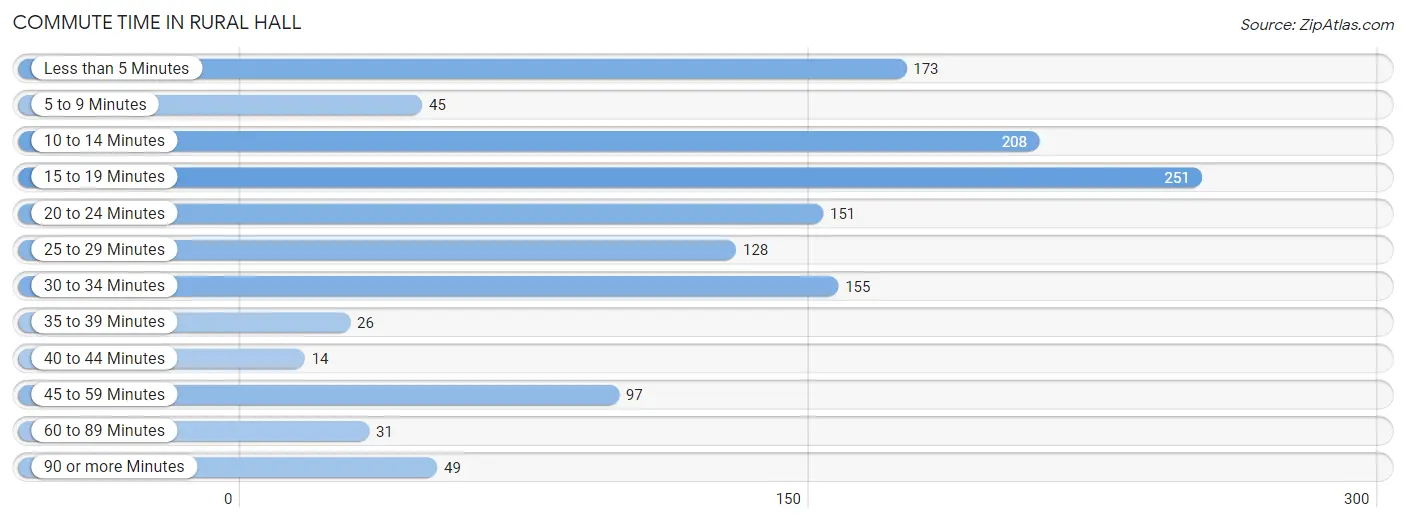
| Commute Time | # Commuters | % Commuters |
| Less than 5 Minutes | 173 | 13.0% |
| 5 to 9 Minutes | 45 | 3.4% |
| 10 to 14 Minutes | 208 | 15.7% |
| 15 to 19 Minutes | 251 | 18.9% |
| 20 to 24 Minutes | 151 | 11.4% |
| 25 to 29 Minutes | 128 | 9.6% |
| 30 to 34 Minutes | 155 | 11.7% |
| 35 to 39 Minutes | 26 | 2.0% |
| 40 to 44 Minutes | 14 | 1.1% |
| 45 to 59 Minutes | 97 | 7.3% |
| 60 to 89 Minutes | 31 | 2.3% |
| 90 or more Minutes | 49 | 3.7% |
Commute Time by Sex in Rural Hall
The most common commute times in Rural Hall are 15 to 19 minutes (126 commuters, 17.1%) for males and 15 to 19 minutes (125 commuters, 21.2%) for females.
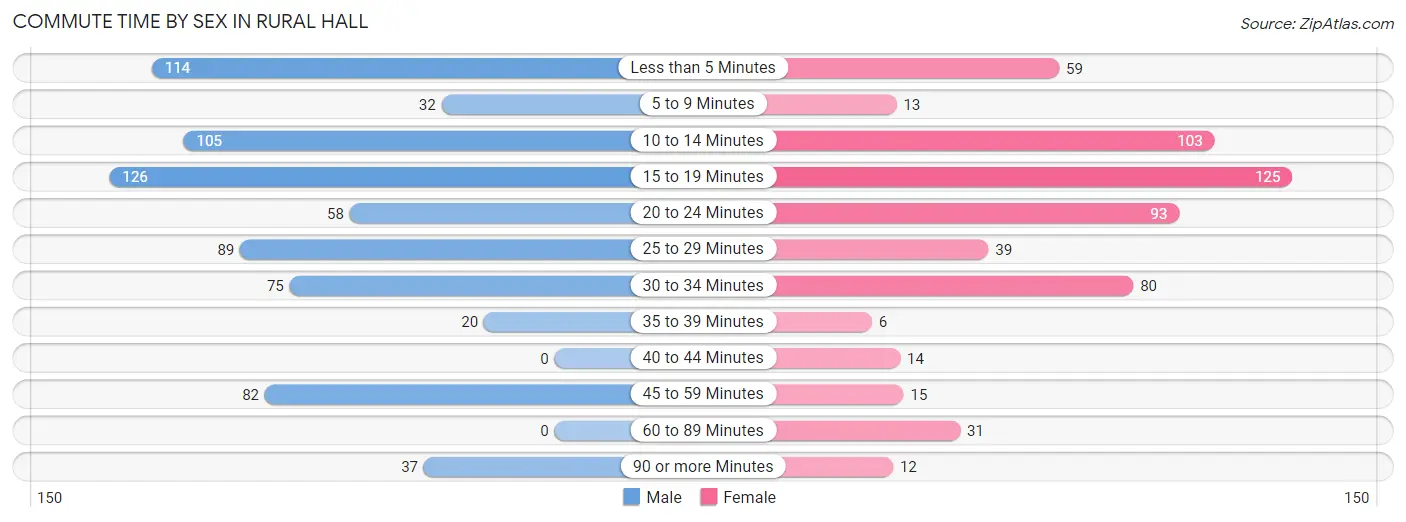
| Commute Time | Male | Female |
| Less than 5 Minutes | 114 (15.4%) | 59 (10.0%) |
| 5 to 9 Minutes | 32 (4.3%) | 13 (2.2%) |
| 10 to 14 Minutes | 105 (14.2%) | 103 (17.5%) |
| 15 to 19 Minutes | 126 (17.1%) | 125 (21.2%) |
| 20 to 24 Minutes | 58 (7.9%) | 93 (15.8%) |
| 25 to 29 Minutes | 89 (12.1%) | 39 (6.6%) |
| 30 to 34 Minutes | 75 (10.2%) | 80 (13.6%) |
| 35 to 39 Minutes | 20 (2.7%) | 6 (1.0%) |
| 40 to 44 Minutes | 0 (0.0%) | 14 (2.4%) |
| 45 to 59 Minutes | 82 (11.1%) | 15 (2.5%) |
| 60 to 89 Minutes | 0 (0.0%) | 31 (5.2%) |
| 90 or more Minutes | 37 (5.0%) | 12 (2.0%) |
Time of Departure to Work by Sex in Rural Hall
The most frequent times of departure to work in Rural Hall are 7:30 AM to 7:59 AM (184, 24.9%) for males and 7:30 AM to 7:59 AM (164, 27.8%) for females.
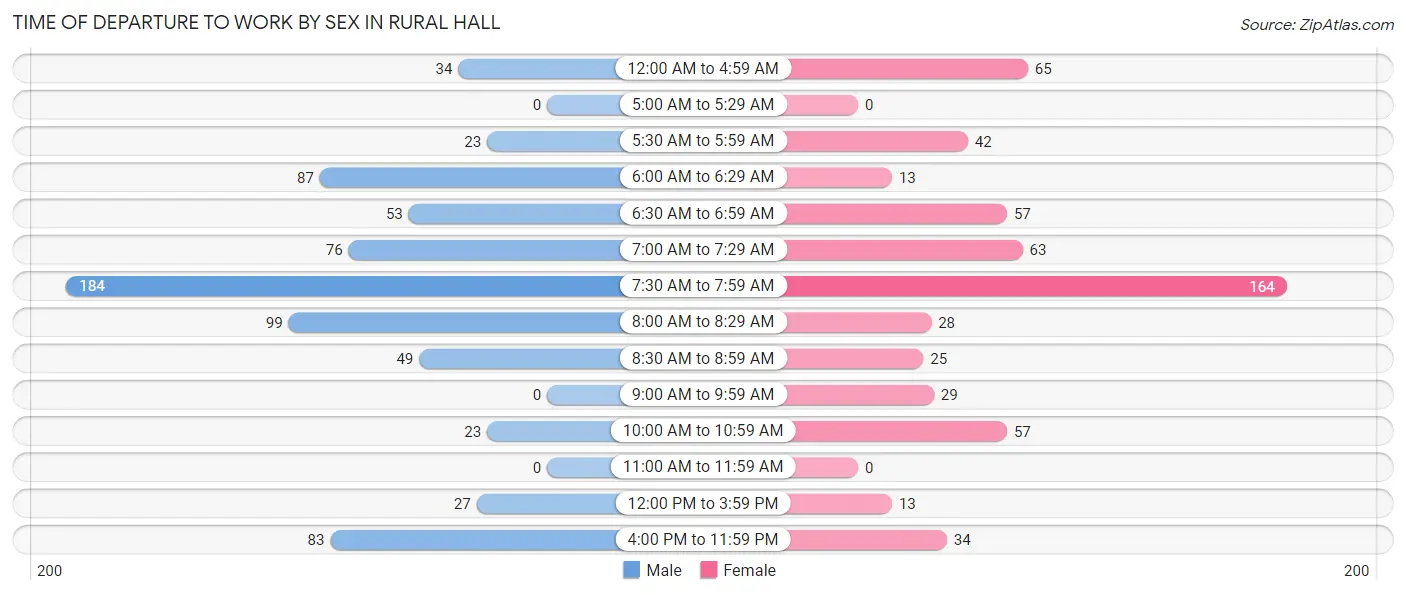
| Time of Departure | Male | Female |
| 12:00 AM to 4:59 AM | 34 (4.6%) | 65 (11.0%) |
| 5:00 AM to 5:29 AM | 0 (0.0%) | 0 (0.0%) |
| 5:30 AM to 5:59 AM | 23 (3.1%) | 42 (7.1%) |
| 6:00 AM to 6:29 AM | 87 (11.8%) | 13 (2.2%) |
| 6:30 AM to 6:59 AM | 53 (7.2%) | 57 (9.7%) |
| 7:00 AM to 7:29 AM | 76 (10.3%) | 63 (10.7%) |
| 7:30 AM to 7:59 AM | 184 (24.9%) | 164 (27.8%) |
| 8:00 AM to 8:29 AM | 99 (13.4%) | 28 (4.8%) |
| 8:30 AM to 8:59 AM | 49 (6.6%) | 25 (4.2%) |
| 9:00 AM to 9:59 AM | 0 (0.0%) | 29 (4.9%) |
| 10:00 AM to 10:59 AM | 23 (3.1%) | 57 (9.7%) |
| 11:00 AM to 11:59 AM | 0 (0.0%) | 0 (0.0%) |
| 12:00 PM to 3:59 PM | 27 (3.7%) | 13 (2.2%) |
| 4:00 PM to 11:59 PM | 83 (11.3%) | 34 (5.8%) |
| Total | 738 (100.0%) | 590 (100.0%) |
Housing Occupancy in Rural Hall
Occupancy by Ownership in Rural Hall
Of the total 1,637 dwellings in Rural Hall, owner-occupied units account for 1,146 (70.0%), while renter-occupied units make up 491 (30.0%).

| Occupancy | # Housing Units | % Housing Units |
| Owner Occupied Housing Units | 1,146 | 70.0% |
| Renter-Occupied Housing Units | 491 | 30.0% |
| Total Occupied Housing Units | 1,637 | 100.0% |
Occupancy by Household Size in Rural Hall

| Household Size | # Housing Units | % Housing Units |
| 1-Person Household | 610 | 37.3% |
| 2-Person Household | 643 | 39.3% |
| 3-Person Household | 275 | 16.8% |
| 4+ Person Household | 109 | 6.7% |
| Total Housing Units | 1,637 | 100.0% |
Occupancy by Ownership by Household Size in Rural Hall

| Household Size | Owner-occupied | Renter-occupied |
| 1-Person Household | 431 (70.7%) | 179 (29.3%) |
| 2-Person Household | 483 (75.1%) | 160 (24.9%) |
| 3-Person Household | 141 (51.3%) | 134 (48.7%) |
| 4+ Person Household | 91 (83.5%) | 18 (16.5%) |
| Total Housing Units | 1,146 (70.0%) | 491 (30.0%) |
Occupancy by Educational Attainment in Rural Hall

| Household Size | Owner-occupied | Renter-occupied |
| Less than High School | 89 (74.2%) | 31 (25.8%) |
| High School Diploma | 355 (68.1%) | 166 (31.9%) |
| College/Associate Degree | 386 (76.6%) | 118 (23.4%) |
| Bachelor's Degree or higher | 316 (64.2%) | 176 (35.8%) |
Occupancy by Age of Householder in Rural Hall

| Age Bracket | # Households | % Households |
| Under 35 Years | 234 | 14.3% |
| 35 to 44 Years | 279 | 17.0% |
| 45 to 54 Years | 258 | 15.8% |
| 55 to 64 Years | 350 | 21.4% |
| 65 to 74 Years | 134 | 8.2% |
| 75 to 84 Years | 202 | 12.3% |
| 85 Years and Over | 180 | 11.0% |
| Total | 1,637 | 100.0% |
Housing Finances in Rural Hall
Median Income by Occupancy in Rural Hall

| Occupancy Type | # Households | Median Income |
| Owner-Occupied | 1,146 (70.0%) | $49,914 |
| Renter-Occupied | 491 (30.0%) | $56,782 |
| Average | 1,637 (100.0%) | $56,037 |
Occupancy by Householder Income Bracket in Rural Hall
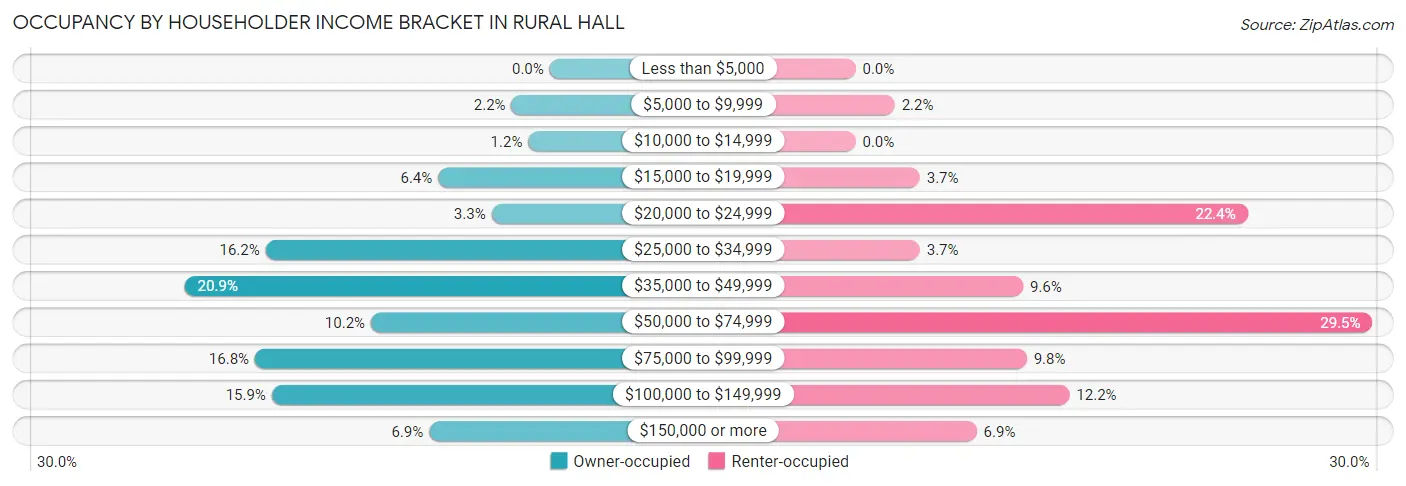
| Income Bracket | Owner-occupied | Renter-occupied |
| Less than $5,000 | 0 (0.0%) | 0 (0.0%) |
| $5,000 to $9,999 | 25 (2.2%) | 11 (2.2%) |
| $10,000 to $14,999 | 14 (1.2%) | 0 (0.0%) |
| $15,000 to $19,999 | 73 (6.4%) | 18 (3.7%) |
| $20,000 to $24,999 | 38 (3.3%) | 110 (22.4%) |
| $25,000 to $34,999 | 186 (16.2%) | 18 (3.7%) |
| $35,000 to $49,999 | 239 (20.9%) | 47 (9.6%) |
| $50,000 to $74,999 | 117 (10.2%) | 145 (29.5%) |
| $75,000 to $99,999 | 193 (16.8%) | 48 (9.8%) |
| $100,000 to $149,999 | 182 (15.9%) | 60 (12.2%) |
| $150,000 or more | 79 (6.9%) | 34 (6.9%) |
| Total | 1,146 (100.0%) | 491 (100.0%) |
Monthly Housing Cost Tiers in Rural Hall

| Monthly Cost | Owner-occupied | Renter-occupied |
| Less than $300 | 183 (16.0%) | 0 (0.0%) |
| $300 to $499 | 263 (23.0%) | 18 (3.7%) |
| $500 to $799 | 180 (15.7%) | 88 (17.9%) |
| $800 to $999 | 95 (8.3%) | 180 (36.7%) |
| $1,000 to $1,499 | 323 (28.2%) | 176 (35.8%) |
| $1,500 to $1,999 | 38 (3.3%) | 18 (3.7%) |
| $2,000 to $2,499 | 24 (2.1%) | 0 (0.0%) |
| $2,500 to $2,999 | 40 (3.5%) | 0 (0.0%) |
| $3,000 or more | 0 (0.0%) | 0 (0.0%) |
| Total | 1,146 (100.0%) | 491 (100.0%) |
Physical Housing Characteristics in Rural Hall
Housing Structures in Rural Hall

| Structure Type | # Housing Units | % Housing Units |
| Single Unit, Detached | 1,305 | 79.7% |
| Single Unit, Attached | 48 | 2.9% |
| 2 Unit Apartments | 0 | 0.0% |
| 3 or 4 Unit Apartments | 35 | 2.1% |
| 5 to 9 Unit Apartments | 59 | 3.6% |
| 10 or more Apartments | 115 | 7.0% |
| Mobile Home / Other | 75 | 4.6% |
| Total | 1,637 | 100.0% |
Housing Structures by Occupancy in Rural Hall

| Structure Type | Owner-occupied | Renter-occupied |
| Single Unit, Detached | 1,036 (79.4%) | 269 (20.6%) |
| Single Unit, Attached | 48 (100.0%) | 0 (0.0%) |
| 2 Unit Apartments | 0 (0.0%) | 0 (0.0%) |
| 3 or 4 Unit Apartments | 0 (0.0%) | 35 (100.0%) |
| 5 to 9 Unit Apartments | 0 (0.0%) | 59 (100.0%) |
| 10 or more Apartments | 0 (0.0%) | 115 (100.0%) |
| Mobile Home / Other | 62 (82.7%) | 13 (17.3%) |
| Total | 1,146 (70.0%) | 491 (30.0%) |
Housing Structures by Number of Rooms in Rural Hall

| Number of Rooms | Owner-occupied | Renter-occupied |
| 1 Room | 0 (0.0%) | 11 (2.2%) |
| 2 or 3 Rooms | 0 (0.0%) | 134 (27.3%) |
| 4 or 5 Rooms | 532 (46.4%) | 208 (42.4%) |
| 6 or 7 Rooms | 315 (27.5%) | 113 (23.0%) |
| 8 or more Rooms | 299 (26.1%) | 25 (5.1%) |
| Total | 1,146 (100.0%) | 491 (100.0%) |
Housing Structure by Heating Type in Rural Hall

| Heating Type | Owner-occupied | Renter-occupied |
| Utility Gas | 204 (17.8%) | 0 (0.0%) |
| Bottled, Tank, or LP Gas | 33 (2.9%) | 11 (2.2%) |
| Electricity | 796 (69.5%) | 480 (97.8%) |
| Fuel Oil or Kerosene | 99 (8.6%) | 0 (0.0%) |
| Coal or Coke | 0 (0.0%) | 0 (0.0%) |
| All other Fuels | 0 (0.0%) | 0 (0.0%) |
| No Fuel Used | 14 (1.2%) | 0 (0.0%) |
| Total | 1,146 (100.0%) | 491 (100.0%) |
Household Vehicle Usage in Rural Hall

| Vehicles per Household | Owner-occupied | Renter-occupied |
| No Vehicle | 0 (0.0%) | 18 (3.7%) |
| 1 Vehicle | 280 (24.4%) | 284 (57.8%) |
| 2 Vehicles | 672 (58.6%) | 90 (18.3%) |
| 3 or more Vehicles | 194 (16.9%) | 99 (20.2%) |
| Total | 1,146 (100.0%) | 491 (100.0%) |
Real Estate & Mortgages in Rural Hall
Real Estate and Mortgage Overview in Rural Hall
| Characteristic | Without Mortgage | With Mortgage |
| Housing Units | 558 | 588 |
| Median Property Value | $168,300 | $172,800 |
| Median Household Income | $41,441 | $64 |
| Monthly Housing Costs | $431 | $0 |
| Real Estate Taxes | $1,276 | $0 |
Property Value by Mortgage Status in Rural Hall

| Property Value | Without Mortgage | With Mortgage |
| Less than $50,000 | 76 (13.6%) | 16 (2.7%) |
| $50,000 to $99,999 | 37 (6.6%) | 28 (4.8%) |
| $100,000 to $299,999 | 445 (79.7%) | 535 (91.0%) |
| $300,000 to $499,999 | 0 (0.0%) | 9 (1.5%) |
| $500,000 to $749,999 | 0 (0.0%) | 0 (0.0%) |
| $750,000 to $999,999 | 0 (0.0%) | 0 (0.0%) |
| $1,000,000 or more | 0 (0.0%) | 0 (0.0%) |
| Total | 558 (100.0%) | 588 (100.0%) |
Household Income by Mortgage Status in Rural Hall

| Household Income | Without Mortgage | With Mortgage |
| Less than $10,000 | 25 (4.5%) | 13 (2.2%) |
| $10,000 to $24,999 | 87 (15.6%) | 0 (0.0%) |
| $25,000 to $34,999 | 118 (21.1%) | 38 (6.5%) |
| $35,000 to $49,999 | 88 (15.8%) | 68 (11.6%) |
| $50,000 to $74,999 | 90 (16.1%) | 151 (25.7%) |
| $75,000 to $99,999 | 94 (16.9%) | 27 (4.6%) |
| $100,000 to $149,999 | 41 (7.3%) | 99 (16.8%) |
| $150,000 or more | 15 (2.7%) | 141 (24.0%) |
| Total | 558 (100.0%) | 588 (100.0%) |
Property Value to Household Income Ratio in Rural Hall

| Value-to-Income Ratio | Without Mortgage | With Mortgage |
| Less than 2.0x | 163 (29.2%) | 83,306 (14,167.7%) |
| 2.0x to 2.9x | 98 (17.6%) | 221 (37.6%) |
| 3.0x to 3.9x | 28 (5.0%) | 147 (25.0%) |
| 4.0x or more | 269 (48.2%) | 44 (7.5%) |
| Total | 558 (100.0%) | 588 (100.0%) |
Real Estate Taxes by Mortgage Status in Rural Hall

| Property Taxes | Without Mortgage | With Mortgage |
| Less than $800 | 84 (15.0%) | 0 (0.0%) |
| $800 to $1,499 | 300 (53.8%) | 51 (8.7%) |
| $800 to $1,499 | 159 (28.5%) | 220 (37.4%) |
| Total | 558 (100.0%) | 588 (100.0%) |
Health & Disability in Rural Hall
Health Insurance Coverage by Age in Rural Hall

| Age Bracket | With Coverage | Without Coverage |
| Under 6 Years | 156 (100.0%) | 0 (0.0%) |
| 6 to 18 Years | 373 (100.0%) | 0 (0.0%) |
| 19 to 25 Years | 165 (90.7%) | 17 (9.3%) |
| 26 to 34 Years | 272 (83.4%) | 54 (16.6%) |
| 35 to 44 Years | 429 (77.2%) | 127 (22.8%) |
| 45 to 54 Years | 397 (86.1%) | 64 (13.9%) |
| 55 to 64 Years | 496 (100.0%) | 0 (0.0%) |
| 65 to 74 Years | 210 (100.0%) | 0 (0.0%) |
| 75 Years and older | 616 (100.0%) | 0 (0.0%) |
| Total | 3,114 (92.2%) | 262 (7.8%) |
Health Insurance Coverage by Citizenship Status in Rural Hall

| Citizenship Status | With Coverage | Without Coverage |
| Native Born | 156 (100.0%) | 0 (0.0%) |
| Foreign Born, Citizen | 373 (100.0%) | 0 (0.0%) |
| Foreign Born, not a Citizen | 165 (90.7%) | 17 (9.3%) |
Health Insurance Coverage by Household Income in Rural Hall

| Household Income | With Coverage | Without Coverage |
| Under $25,000 | 179 (61.9%) | 110 (38.1%) |
| $25,000 to $49,999 | 898 (94.3%) | 54 (5.7%) |
| $50,000 to $74,999 | 550 (92.1%) | 47 (7.9%) |
| $75,000 to $99,999 | 580 (97.2%) | 17 (2.9%) |
| $100,000 and over | 907 (96.4%) | 34 (3.6%) |
Public vs Private Health Insurance Coverage by Age in Rural Hall

| Age Bracket | Public Insurance | Private Insurance |
| Under 6 | 93 (59.6%) | 97 (62.2%) |
| 6 to 18 Years | 168 (45.0%) | 205 (55.0%) |
| 19 to 25 Years | 0 (0.0%) | 165 (90.7%) |
| 25 to 34 Years | 47 (14.4%) | 241 (73.9%) |
| 35 to 44 Years | 122 (21.9%) | 401 (72.1%) |
| 45 to 54 Years | 42 (9.1%) | 367 (79.6%) |
| 55 to 64 Years | 58 (11.7%) | 438 (88.3%) |
| 65 to 74 Years | 210 (100.0%) | 181 (86.2%) |
| 75 Years and over | 603 (97.9%) | 397 (64.4%) |
| Total | 1,343 (39.8%) | 2,492 (73.8%) |
Disability Status by Sex by Age in Rural Hall

| Age Bracket | Male | Female |
| Under 5 Years | 0 (0.0%) | 0 (0.0%) |
| 5 to 17 Years | 0 (0.0%) | 0 (0.0%) |
| 18 to 34 Years | 0 (0.0%) | 0 (0.0%) |
| 35 to 64 Years | 60 (8.8%) | 115 (13.8%) |
| 65 to 74 Years | 0 (0.0%) | 29 (28.2%) |
| 75 Years and over | 76 (33.0%) | 202 (52.3%) |
Disability Class by Sex by Age in Rural Hall
Disability Class: Hearing Difficulty

| Age Bracket | Male | Female |
| Under 5 Years | 0 (0.0%) | 0 (0.0%) |
| 5 to 17 Years | 0 (0.0%) | 0 (0.0%) |
| 18 to 34 Years | 0 (0.0%) | 0 (0.0%) |
| 35 to 64 Years | 15 (2.2%) | 0 (0.0%) |
| 65 to 74 Years | 0 (0.0%) | 0 (0.0%) |
| 75 Years and over | 34 (14.8%) | 82 (21.2%) |
Disability Class: Vision Difficulty

| Age Bracket | Male | Female |
| Under 5 Years | 0 (0.0%) | 0 (0.0%) |
| 5 to 17 Years | 0 (0.0%) | 0 (0.0%) |
| 18 to 34 Years | 0 (0.0%) | 0 (0.0%) |
| 35 to 64 Years | 0 (0.0%) | 0 (0.0%) |
| 65 to 74 Years | 0 (0.0%) | 0 (0.0%) |
| 75 Years and over | 0 (0.0%) | 33 (8.6%) |
Disability Class: Cognitive Difficulty

| Age Bracket | Male | Female |
| 5 to 17 Years | 0 (0.0%) | 0 (0.0%) |
| 18 to 34 Years | 0 (0.0%) | 0 (0.0%) |
| 35 to 64 Years | 31 (4.6%) | 101 (12.1%) |
| 65 to 74 Years | 0 (0.0%) | 13 (12.6%) |
| 75 Years and over | 53 (23.0%) | 63 (16.3%) |
Disability Class: Ambulatory Difficulty

| Age Bracket | Male | Female |
| 5 to 17 Years | 0 (0.0%) | 0 (0.0%) |
| 18 to 34 Years | 0 (0.0%) | 0 (0.0%) |
| 35 to 64 Years | 0 (0.0%) | 14 (1.7%) |
| 65 to 74 Years | 0 (0.0%) | 16 (15.5%) |
| 75 Years and over | 68 (29.6%) | 112 (29.0%) |
Disability Class: Self-Care Difficulty

| Age Bracket | Male | Female |
| 5 to 17 Years | 0 (0.0%) | 0 (0.0%) |
| 18 to 34 Years | 0 (0.0%) | 0 (0.0%) |
| 35 to 64 Years | 0 (0.0%) | 0 (0.0%) |
| 65 to 74 Years | 0 (0.0%) | 16 (15.5%) |
| 75 Years and over | 27 (11.7%) | 44 (11.4%) |
Technology Access in Rural Hall
Computing Device Access in Rural Hall

| Device Type | # Households | % Households |
| Desktop or Laptop | 1,294 | 79.0% |
| Smartphone | 1,352 | 82.6% |
| Tablet | 956 | 58.4% |
| No Computing Device | 212 | 13.0% |
| Total | 1,637 | 100.0% |
Internet Access in Rural Hall

| Internet Type | # Households | % Households |
| Dial-Up Internet | 0 | 0.0% |
| Broadband Home | 1,255 | 76.7% |
| Cellular Data Only | 60 | 3.7% |
| Satellite Internet | 49 | 3.0% |
| No Internet | 286 | 17.5% |
| Total | 1,637 | 100.0% |
Rural Hall Summary
Rural Hall is a small town located in Forsyth County, North Carolina. It is situated in the foothills of the Blue Ridge Mountains, approximately 20 miles north of Winston-Salem. The town was founded in 1845 and has a population of approximately 2,000 people.
Geography
Rural Hall is located in the Piedmont region of North Carolina, which is characterized by rolling hills and valleys. The town is situated in the Yadkin Valley, which is part of the larger Appalachian Mountains region. The town is located at an elevation of 890 feet above sea level. The town is located in the Yadkin River watershed, which is part of the larger Catawba River watershed. The town is located in the Yadkin Valley AVA, which is an American Viticultural Area.
The town is located in the Piedmont Triad region, which is composed of the cities of Winston-Salem, Greensboro, and High Point. The town is located approximately 20 miles north of Winston-Salem and approximately 40 miles south of Greensboro. The town is located along US Highway 52, which is a major north-south highway in the region.
Climate
Rural Hall has a humid subtropical climate, which is characterized by hot, humid summers and mild winters. The average annual temperature is 61 degrees Fahrenheit, with an average high of 79 degrees Fahrenheit in the summer and an average low of 43 degrees Fahrenheit in the winter. The average annual precipitation is 44 inches, with an average of 4 inches of snowfall per year.
Demographics
As of the 2010 census, the population of Rural Hall was 2,039. The racial makeup of the town was 91.3% White, 5.2% African American, 0.7% Native American, 0.4% Asian, 0.1% Pacific Islander, 0.9% from other races, and 1.4% from two or more races. Hispanic or Latino of any race were 2.3% of the population.
The median household income in Rural Hall was $41,250, and the median family income was $50,000. The per capita income for the town was $20,845. About 11.2% of families and 14.2% of the population were below the poverty line, including 18.2% of those under age 18 and 8.3% of those age 65 or over.
Economy
Rural Hall is a small, rural town with a primarily agricultural economy. The town is home to several farms, including dairy farms, poultry farms, and vegetable farms. The town is also home to several small businesses, including restaurants, retail stores, and service providers. The town is also home to several manufacturing companies, including a furniture manufacturer and a plastics manufacturer.
The town is also home to several educational institutions, including a community college and a technical college. The town is also home to several churches, including Baptist, Methodist, and Presbyterian churches.
Conclusion
Rural Hall is a small town located in Forsyth County, North Carolina. It is situated in the foothills of the Blue Ridge Mountains, approximately 20 miles north of Winston-Salem. The town was founded in 1845 and has a population of approximately 2,000 people. The town has a humid subtropical climate and is home to several farms, businesses, educational institutions, and churches. The town has a primarily agricultural economy, with several small businesses, manufacturing companies, and educational institutions. The median household income in Rural Hall was $41,250, and the median family income was $50,000.
Common Questions
What is Per Capita Income in Rural Hall?
Per Capita income in Rural Hall is $37,702.
What is the Median Family Income in Rural Hall?
Median Family Income in Rural Hall is $71,987.
What is the Median Household income in Rural Hall?
Median Household Income in Rural Hall is $56,037.
What is Income or Wage Gap in Rural Hall?
Income or Wage Gap in Rural Hall is 17.4%.
Women in Rural Hall earn 82.6 cents for every dollar earned by a man.
What is Inequality or Gini Index in Rural Hall?
Inequality or Gini Index in Rural Hall is 0.48.
What is the Total Population of Rural Hall?
Total Population of Rural Hall is 3,376.
What is the Total Male Population of Rural Hall?
Total Male Population of Rural Hall is 1,459.
What is the Total Female Population of Rural Hall?
Total Female Population of Rural Hall is 1,917.
What is the Ratio of Males per 100 Females in Rural Hall?
There are 76.11 Males per 100 Females in Rural Hall.
What is the Ratio of Females per 100 Males in Rural Hall?
There are 131.39 Females per 100 Males in Rural Hall.
What is the Median Population Age in Rural Hall?
Median Population Age in Rural Hall is 46.8 Years.
What is the Average Family Size in Rural Hall
Average Family Size in Rural Hall is 2.7 People.
What is the Average Household Size in Rural Hall
Average Household Size in Rural Hall is 2.1 People.
How Large is the Labor Force in Rural Hall?
There are 1,721 People in the Labor Forcein in Rural Hall.
What is the Percentage of People in the Labor Force in Rural Hall?
59.5% of People are in the Labor Force in Rural Hall.
What is the Unemployment Rate in Rural Hall?
Unemployment Rate in Rural Hall is 13.4%.